Tanenbaum A. Computer Networks
Подождите немного. Документ загружается.

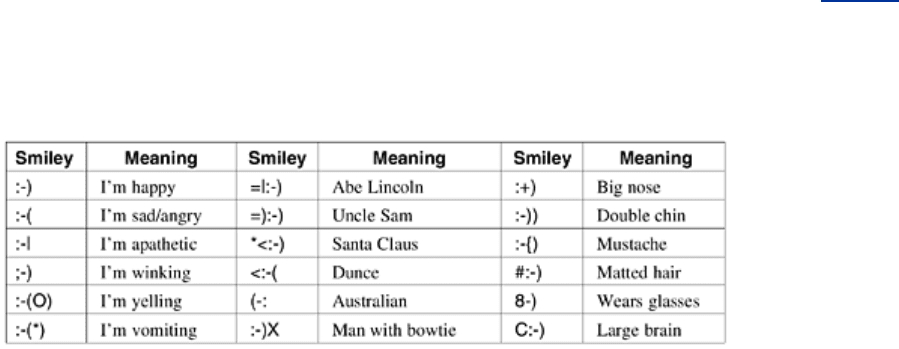
has been defined, called LDAP (Lightweight Directory Access Protocol). It is a simplified
version of the OSI X.500 directory service and is described in RFC 2251. It organizes
information as a tree and allows searches on different components. It can be regarded as a
''white pages'' telephone book. We will not discuss it further in this book, but for more
information see (Weltman and Dahbura, 2000).
7.2 Electronic Mail
Electronic mail, or e-mail, as it is known to its many fans, has been around for over two
decades. Before 1990, it was mostly used in academia. During the 1990s, it became known to
the public at large and grew exponentially to the point where the number of e-mails sent per
day now is vastly more than the number of
snail mail (i.e., paper) letters.
E-mail, like most other forms of communication, has its own conventions and styles. In
particular, it is very informal and has a low threshold of use. People who would never dream of
calling up or even writing a letter to a Very Important Person do not hesitate for a second to
send a sloppily-written e-mail.
E-mail is full of jargon such as BTW (By The Way), ROTFL (Rolling On The Floor Laughing), and
IMHO (In My Humble Opinion). Many people also use little ASCII symbols called
smileys or
emoticons in their e-mail. A few of the more interesting ones are reproduced in Fig. 7-6. For
most, rotating the book 90 degrees clockwise will make them clearer. For a minibook giving
over 650 smileys, see (Sanderson and Dougherty, 1993).
Figure 7-6. Some smileys. They will not be on the final exam :-)
The first e-mail systems simply consisted of file transfer protocols, with the convention that
the first line of each message (i.e., file) contained the recipient's address. As time went on, the
limitations of this approach became more obvious.
Some of the complaints were as follows:
1. Sending a message to a group of people was inconvenient. Managers often need this
facility to send memos to all their subordinates.
2. Messages had no internal structure, making computer processing difficult. For example,
if a forwarded message was included in the body of another message, extracting the
forwarded part from the received message was difficult.
3. The originator (sender) never knew if a message arrived or not.
4. If someone was planning to be away on business for several weeks and wanted all
incoming e-mail to be handled by his secretary, this was not easy to arrange.
5. The user interface was poorly integrated with the transmission system requiring users
first to edit a file, then leave the editor and invoke the file transfer program.
6. It was not possible to create and send messages containing a mixture of text, drawings,
facsimile, and voice.
451
As experience was gained, more elaborate e-mail systems were proposed. In 1982, the
ARPANET e-mail proposals were published as RFC 821 (transmission protocol) and RFC 822
(message format). Minor revisions, RFC 2821 and RFC 2822, have become Internet standards,
but everyone still refers to Internet e-mail as RFC 822.
In 1984, CCITT drafted its X.400 recommendation. After two decades of competition, e-mail
systems based on RFC 822 are widely used, whereas those based on X.400 have disappeared.
How a system hacked together by a handful of computer science graduate students beat an
official international standard strongly backed by all the PTTs in the world, many governments,
and a substantial part of the computer industry brings to mind the Biblical story of David and
Goliath.
The reason for RFC 822's success is not that it is so good, but that X.400 was so poorly
designed and so complex that nobody could implement it well. Given a choice between a
simple-minded, but working, RFC 822-based e-mail system and a supposedly truly wonderful,
but nonworking, X.400 e-mail system, most organizations chose the former. Perhaps there is a
lesson lurking in there somewhere. Consequently, our discussion of e-mail will focus on the
Internet e-mail system.
7.2.1 Architecture and Services
In this section we will provide an overview of what e-mail systems can do and how they are
organized. They normally consist of two subsystems: the
user agents, which allow people to
read and send e-mail, and the
message transfer agents, which move the messages from
the source to the destination. The user agents are local programs that provide a command-
based, menu-based, or graphical method for interacting with the e-mail system. The message
transfer agents are typically system
daemons, that is, processes that run in the background.
Their job is to move e-mail through the system.
Typically, e-mail systems support five basic functions. Let us take a look at them.
Composition refers to the process of creating messages and answers. Although any text
editor can be used for the body of the message, the system itself can provide assistance with
addressing and the numerous header fields attached to each message. For example, when
answering a message, the e-mail system can extract the originator's address from the
incoming e-mail and automatically insert it into the proper place in the reply.
Transfer refers to moving messages from the originator to the recipient. In large part, this
requires establishing a connection to the destination or some intermediate machine, outputting
the message, and releasing the connection. The e-mail system should do this automatically,
without bothering the user.
Reporting has to do with telling the originator what happened to the message. Was it
delivered? Was it rejected? Was it lost? Numerous applications exist in which confirmation of
delivery is important and may even have legal significance (''Well, Your Honor, my e-mail
system is not very reliable, so I guess the electronic subpoena just got lost somewhere'').
Displaying incoming messages is needed so people can read their e-mail. Sometimes
conversion is required or a special viewer must be invoked, for example, if the message is a
PostScript file or digitized voice. Simple conversions and formatting are sometimes attempted
as well.
Disposition is the final step and concerns what the recipient does with the message after
receiving it. Possibilities include throwing it away before reading, throwing it away after
reading, saving it, and so on. It should also be possible to retrieve and reread saved
messages, forward them, or process them in other ways.
452

In addition to these basic services, some e-mail systems, especially internal corporate ones,
provide a variety of advanced features. Let us just briefly mention a few of these. When people
move or when they are away for some period of time, they may want their e-mail forwarded,
so the system should be able to do this automatically.
Most systems allow users to create
mailboxes to store incoming e-mail. Commands are
needed to create and destroy mailboxes, inspect the contents of mailboxes, insert and delete
messages from mailboxes, and so on.
Corporate managers often need to send a message to each of their subordinates, customers,
or suppliers. This gives rise to the idea of a
mailing list, which is a list of e-mail addresses.
When a message is sent to the mailing list, identical copies are delivered to everyone on the
list.
Other advanced features are carbon copies, blind carbon copies, high-priority e-mail, secret
(i.e., encrypted) e-mail, alternative recipients if the primary one is not currently available, and
the ability for secretaries to read and answer their bosses' e-mail.
E-mail is now widely used within industry for intracompany communication. It allows far-flung
employees to cooperate on complex projects, even over many time zones. By eliminating most
cues associated with rank, age, and gender, e-mail debates tend to focus on ideas, not on
corporate status. With e-mail, a brilliant idea from a summer student can have more impact
than a dumb one from an executive vice president.
A key idea in e-mail systems is the distinction between the
envelope and its contents. The
envelope encapsulates the message. It contains all the information needed for transporting the
message, such as the destination address, priority, and security level, all of which are distinct
from the message itself. The message transport agents use the envelope for routing, just as
the post office does.
The message inside the envelope consists of two parts: the
header and the body. The header
contains control information for the user agents. The body is entirely for the human recipient.
Envelopes and messages are illustrated in
Fig. 7-7.
Figure 7-7. Envelopes and messages. (a) Paper mail. (b) Electronic
mail.
453
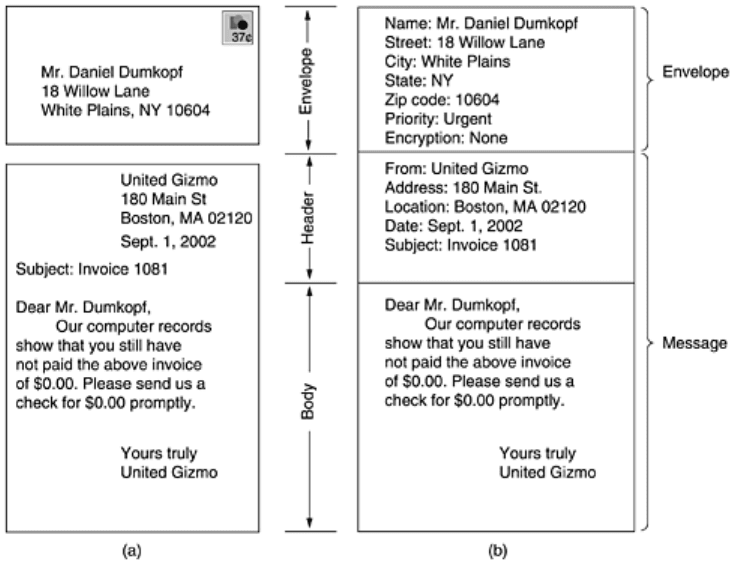
7.2.2 The User Agent
E-mail systems have two basic parts, as we have seen: the user agents and the message
transfer agents. In this section we will look at the user agents. A user agent is normally a
program (sometimes called a mail reader) that accepts a variety of commands for composing,
receiving, and replying to messages, as well as for manipulating mailboxes. Some user agents
have a fancy menu- or icon-driven interface that requires a mouse, whereas others expect 1-
character commands from the keyboard. Functionally, these are the same. Some systems are
menu- or icon-driven but also have keyboard shortcuts.
Sending E-mail
To send an e-mail message, a user must provide the message, the destination address, and
possibly some other parameters. The message can be produced with a free-standing text
editor, a word processing program, or possibly with a specialized text editor built into the user
agent. The destination address must be in a format that the user agent can deal with. Many
user agents expect addresses of the form
user@dns-address. Since we have studied DNS
earlier in this chapter, we will not repeat that material here.
However, it is worth noting that other forms of addressing exist. In particular, X.400 addresses
look radically different from DNS addresses. They are composed of
attribute = value pairs
separated by slashes, for example,
/C=US/ST=MASSACHUSETTS/L=CAMBRIDGE/PA=360 MEMORIAL DR./CN=KEN SMITH/
This address specifies a country, state, locality, personal address and a common name (Ken
Smith). Many other attributes are possible, so you can send e-mail to someone whose exact e-
mail address you do not know, provided you know enough other attributes (e.g., company and
job title). Although X.400 names are considerably less convenient than DNS names, most e-
mail systems have aliases (sometimes called nicknames) that allow users to enter or select a
person's name and get the correct e-mail address. Consequently, even with X.400 addresses,
it is usually not necessary to actually type in these strange strings.
454
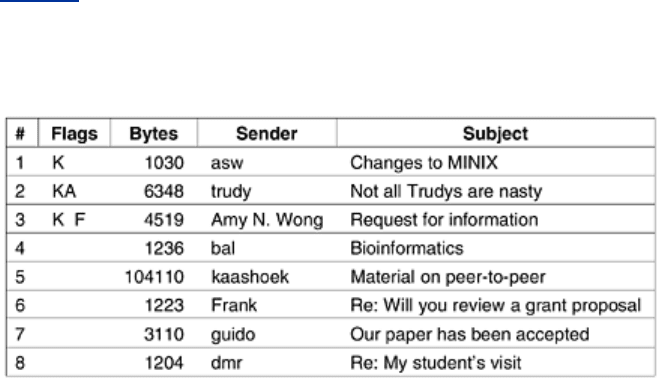
Most e-mail systems support mailing lists, so that a user can send the same message to a list
of people with a single command. If the mailing list is maintained locally, the user agent can
just send a separate message to each intended recipient. However, if the list is maintained
remotely, then messages will be expanded there. For example, if a group of bird watchers has
a mailing list called
birders installed on meadowlark.arizona.edu, then any message sent to
birders@meadowlark.arizona.edu will be routed to the University of Arizona and expanded
there into individual messages to all the mailing list members, wherever in the world they may
be. Users of this mailing list cannot tell that it is a mailing list. It could just as well be the
personal mailbox of Prof. Gabriel O. Birders.
Reading E-mail
Typically, when a user agent is started up, it looks at the user's mailbox for incoming e-mail
before displaying anything on the screen. Then it may announce the number of messages in
the mailbox or display a one-line summary of each one and wait for a command.
As an example of how a user agent works, let us take a look at a typical mail scenario. After
starting up the user agent, the user asks for a summary of his e-mail. A display like that of
Fig. 7-8 then appears on the screen. Each line refers to one message. In this example, the
mailbox contains eight messages.
Figure 7-8. An example display of the contents of a mailbox.
Each line of the display contains several fields extracted from the envelope or header of the
corresponding message. In a simple e-mail system, the choice of fields displayed is built into
the program. In a more sophisticated system, the user can specify which fields are to be
displayed by providing a
user profile, a file describing the display format. In this basic
example, the first field is the message number. The second field,
Flags, can contain a K,
meaning that the message is not new but was read previously and kept in the mailbox; an
A,
meaning that the message has already been answered; and/or an
F, meaning that the
message has been forwarded to someone else. Other flags are also possible.
The third field tells how long the message is, and the fourth one tells who sent the message.
Since this field is simply extracted from the message, this field may contain first names, full
names, initials, login names, or whatever else the sender chooses to put there. Finally, the
Subject field gives a brief summary of what the message is about. People who fail to include a
Subject field often discover that responses to their e-mail tend not to get the highest priority.
After the headers have been displayed, the user can perform any of several actions, such as
displaying a message, deleting a message, and so on. The older systems were text based and
typically used one-character commands for performing these tasks, such as T (type message),
A (answer message), D (delete message), and F (forward message). An argument specified
the message in question. More recent systems use graphical interfaces. Usually, the user
selects a message with the mouse and then clicks on an icon to type, answer, delete, or
forward it.
455
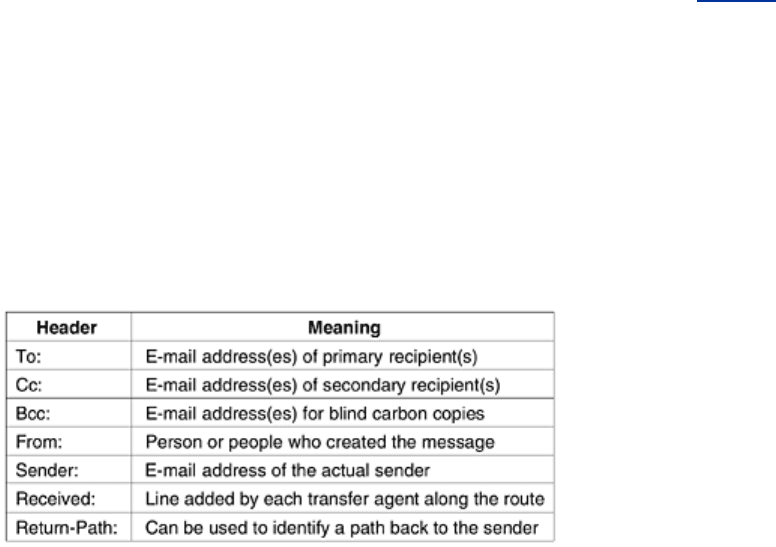
E-mail has come a long way from the days when it was just file transfer. Sophisticated user
agents make managing a large volume of e-mail possible. For people who receive and send
thousands of messages a year, such tools are invaluable.
7.2.3 Message Formats
Let us now turn from the user interface to the format of the e-mail messages themselves. First
we will look at basic ASCII e-mail using RFC 822. After that, we will look at multimedia
extensions to RFC 822.
RFC 822
Messages consist of a primitive envelope (described in RFC 821), some number of header
fields, a blank line, and then the message body. Each header field (logically) consists of a
single line of ASCII text containing the field name, a colon, and, for most fields, a value. RFC
822 was designed decades ago and does not clearly distinguish the envelope fields from the
header fields. Although it was revised in RFC 2822, completely redoing it was not possible due
to its widespread usage. In normal usage, the user agent builds a message and passes it to
the message transfer agent, which then uses some of the header fields to construct the actual
envelope, a somewhat old-fashioned mixing of message and envelope.
The principal header fields related to message transport are listed in
Fig. 7-9. The To: field
gives the DNS address of the primary recipient. Having multiple recipients is also allowed. The
Cc: field gives the addresses of any secondary recipients. In terms of delivery, there is no
distinction between the primary and secondary recipients. It is entirely a psychological
difference that may be important to the people involved but is not important to the mail
system. The term
Cc: (Carbon copy) is a bit dated, since computers do not use carbon paper,
but it is well established. The
Bcc: (Blind carbon copy) field is like the Cc: field, except that
this line is deleted from all the copies sent to the primary and secondary recipients. This
feature allows people to send copies to third parties without the primary and secondary
recipients knowing this.
Figure 7-9. RFC 822 header fields related to message transport.
The next two fields,
From: and Sender:, tell who wrote and sent the message, respectively.
These need not be the same. For example, a business executive may write a message, but her
secretary may be the one who actually transmits it. In this case, the executive would be listed
in the
From: field and the secretary in the Sender: field. The From: field is required, but the
Sender: field may be omitted if it is the same as the From: field. These fields are needed in
case the message is undeliverable and must be returned to the sender.
A line containing
Received: is added by each message transfer agent along the way. The line
contains the agent's identity, the date and time the message was received, and other
information that can be used for finding bugs in the routing system.
456

The Return-Path: field is added by the final message transfer agent and was intended to tell
how to get back to the sender. In theory, this information can be gathered from all the
Received: headers (except for the name of the sender's mailbox), but it is rarely filled in as
such and typically just contains the sender's address.
In addition to the fields of
Fig. 7-9, RFC 822 messages may also contain a variety of header
fields used by the user agents or human recipients. The most common ones are listed in
Fig.
7-10. Most of these are self-explanatory, so we will not go into all of them in detail.
Figure 7-10. Some fields used in the RFC 822 message header.
The
Reply-To: field is sometimes used when neither the person composing the message nor
the person sending the message wants to see the reply. For example, a marketing manager
writes an e-mail message telling customers about a new product. The message is sent by a
secretary, but the
Reply-To: field lists the head of the sales department, who can answer
questions and take orders. This field is also useful when the sender has two e-mail accounts
and wants the reply to go to the other one.
The RFC 822 document explicitly says that users are allowed to invent new headers for their
own private use, provided that these headers start with the string
X-. It is guaranteed that no
future headers will use names starting with
X-, to avoid conflicts between official and private
headers. Sometimes wiseguy undergraduates make up fields like
X-Fruit-of-the-Day: or X-
Disease-of-the-Week:
, which are legal, although not always illuminating.
After the headers comes the message body. Users can put whatever they want here. Some
people terminate their messages with elaborate signatures, including simple ASCII cartoons,
quotations from greater and lesser authorities, political statements, and disclaimers of all kinds
(e.g., The XYZ Corporation is not responsible for my opinions; in fact, it cannot even
comprehend them).
MIME—The Multipurpose Internet Mail Extensions
In the early days of the ARPANET, e-mail consisted exclusively of text messages written in
English and expressed in ASCII. For this environment, RFC 822 did the job completely: it
specified the headers but left the content entirely up to the users. Nowadays, on the worldwide
Internet, this approach is no longer adequate. The problems include sending and receiving
1. Messages in languages with accents (e.g., French and German).
2. Messages in non-Latin alphabets (e.g., Hebrew and Russian).
3. Messages in languages without alphabets (e.g., Chinese and Japanese).
4. Messages not containing text at all (e.g., audio or images).
A solution was proposed in RFC 1341 and updated in RFCs 2045–2049. This solution, called
MIME (Multipurpose Internet Mail Extensions) is now widely used. We will now describe
it. For additional information about MIME, see the RFCs.
457
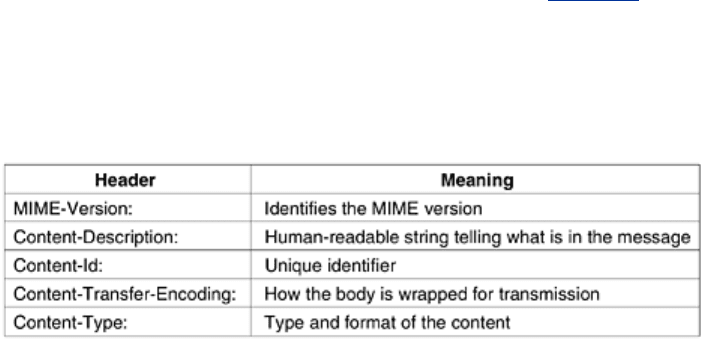
The basic idea of MIME is to continue to use the RFC 822 format, but to add structure to the
message body and define encoding rules for non-ASCII messages. By not deviating from RFC
822, MIME messages can be sent using the existing mail programs and protocols. All that has
to be changed are the sending and receiving programs, which users can do for themselves.
MIME defines five new message headers, as shown in
Fig. 7-11. The first of these simply tells
the user agent receiving the message that it is dealing with a MIME message, and which
version of MIME it uses. Any message not containing a
MIME-Version: header is assumed to be
an English plaintext message and is processed as such.
Figure 7-11. RFC 822 headers added by MIME.
The
Content-Description: header is an ASCII string telling what is in the message. This header
is needed so the recipient will know whether it is worth decoding and reading the message. If
the string says: ''Photo of Barbara's hamster'' and the person getting the message is not a big
hamster fan, the message will probably be discarded rather than decoded into a high-
resolution color photograph.
The
Content-Id: header identifies the content. It uses the same format as the standard
Message-Id: header.
The
Content-Transfer-Encoding: tells how the body is wrapped for transmission through a
network that may object to most characters other than letters, numbers, and punctuation
marks. Five schemes (plus an escape to new schemes) are provided. The simplest scheme is
just ASCII text. ASCII characters use 7 bits and can be carried directly by the e-mail protocol
provided that no line exceeds 1000 characters.
The next simplest scheme is the same thing, but using 8-bit characters, that is, all values from
0 up to and including 255. This encoding scheme violates the (original) Internet e-mail
protocol but is used by some parts of the Internet that implement some extensions to the
original protocol. While declaring the encoding does not make it legal, having it explicit may at
least explain things when something goes wrong. Messages using the 8-bit encoding must still
adhere to the standard maximum line length.
Even worse are messages that use binary encoding. These are arbitrary binary files that not
only use all 8 bits but also do not even respect the 1000-character line limit. Executable
programs fall into this category. No guarantee is given that messages in binary will arrive
correctly, but some people try anyway.
The correct way to encode binary messages is to use
base64 encoding, sometimes called
ASCII armor. In this scheme, groups of 24 bits are broken up into four 6-bit units, with each
unit being sent as a legal ASCII character. The coding is ''A'' for 0, ''B'' for 1, and so on,
followed by the 26 lower-case letters, the ten digits, and finally + and / for 62 and 63,
respectively. The == and = sequences indicate that the last group contained only 8 or 16 bits,
respectively. Carriage returns and line feeds are ignored, so they can be inserted at will to
keep the lines short enough. Arbitrary binary text can be sent safely using this scheme.
458
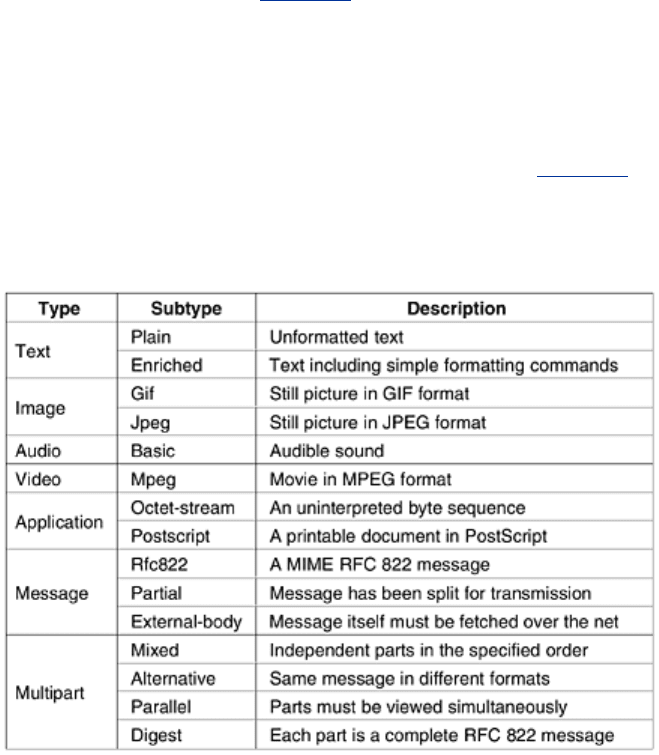
For messages that are almost entirely ASCII but with a few non-ASCII characters, base64
encoding is somewhat inefficient. Instead, an encoding known as
quoted-printable encoding
is used. This is just 7-bit ASCII, with all the characters above 127 encoded as an equal sign
followed by the character's value as two hexadecimal digits.
In summary, binary data should be sent encoded in base64 or quoted-printable form. When
there are valid reasons not to use one of these schemes, it is possible to specify a user-defined
encoding in the
Content-Transfer-Encoding: header.
The last header shown in
Fig. 7-11 is really the most interesting one. It specifies the nature of
the message body. Seven types are defined in RFC 2045, each of which has one or more
subtypes. The type and subtype are separated by a slash, as in
Content-Type: video/mpeg
The subtype must be given explicitly in the header; no defaults are provided. The initial list of
types and subtypes specified in RFC 2045 is given in
Fig. 7-12. Many new ones have been
added since then, and additional entries are being added all the time as the need arises.
Figure 7-12. The MIME types and subtypes defined in RFC 2045.
Let us now go briefly through the list of types. The
text type is for straight ASCII text. The
text/plain combination is for ordinary messages that can be displayed as received, with no
encoding and no further processing. This option allows ordinary messages to be transported in
MIME with only a few extra headers.
The
text/enriched subtype allows a simple markup language to be included in the text. This
language provides a system-independent way to express boldface, italics, smaller and larger
point sizes, indentation, justification, sub- and superscripting, and simple page layout. The
markup language is based on SGML, the Standard Generalized Markup Language also used as
the basis for the World Wide Web's HTML. For example, the message
The <bold> time </bold> has come the <italic> walrus </italic> said ...
would be displayed as
459
The time has come the walrus said ...
It is up to the receiving system to choose the appropriate rendition. If boldface and italics are
available, they can be used; otherwise, colors, blinking, underlining, reverse video, etc., can
be used for emphasis. Different systems can, and do, make different choices.
When the Web became popular, a new subtype
text/html was added (in RFC 2854) to allow
Web pages to be sent in RFC 822 e-mail. A subtype for the extensible markup language,
text/xml, is defined in RFC 3023. We will study HTML and XML later in this chapter.
The next MIME type is
image, which is used to transmit still pictures. Many formats are widely
used for storing and transmitting images nowadays, both with and without compression. Two
of these, GIF and JPEG, are built into nearly all browsers, but many others exist as well and
have been added to the original list.
The
audio and video types are for sound and moving pictures, respectively. Please note that
video includes only the visual information, not the soundtrack. If a movie with sound is to be
transmitted, the video and audio portions may have to be transmitted separately, depending
on the encoding system used. The first video format defined was the one devised by the
modestly-named Moving Picture Experts Group (MPEG), but others have been added since. In
addition to
audio/basic, a new audio type, audio/mpeg was added in RFC 3003 to allow people
to e-mail MP3 audio files.
The
application type is a catchall for formats that require external processing not covered by
one of the other types. An
octet-stream is just a sequence of uninterpreted bytes. Upon
receiving such a stream, a user agent should probably display it by suggesting to the user that
it be copied to a file and prompting for a file name. Subsequent processing is then up to the
user.
The other defined subtype is
postscript, which refers to the PostScript language defined by
Adobe Systems and widely used for describing printed pages. Many printers have built-in
PostScript interpreters. Although a user agent can just call an external PostScript interpreter to
display incoming PostScript files, doing so is not without some danger. PostScript is a full-
blown programming language. Given enough time, a sufficiently masochistic person could write
a C compiler or a database management system in PostScript. Displaying an incoming
PostScript message is done by executing the PostScript program contained in it. In addition to
displaying some text, this program can read, modify, or delete the user's files, and have other
nasty side effects.
The
message type allows one message to be fully encapsulated inside another. This scheme is
useful for forwarding e-mail, for example. When a complete RFC 822 message is encapsulated
inside an outer message, the
rfc822 subtype should be used.
The
partial subtype makes it possible to break an encapsulated message into pieces and send
them separately (for example, if the encapsulated message is too long). Parameters make it
possible to reassemble all the parts at the destination in the correct order.
Finally, the
external-body subtype can be used for very long messages (e.g., video films).
Instead of including the MPEG file in the message, an FTP address is given and the receiver's
user agent can fetch it over the network at the time it is needed. This facility is especially
useful when sending a movie to a mailing list of people, only a few of whom are expected to
view it (think about electronic junk mail containing advertising videos).
The final type is
multipart, which allows a message to contain more than one part, with the
beginning and end of each part being clearly delimited. The
mixed subtype allows each part to
be different, with no additional structure imposed. Many e-mail programs allow the user to
460
